Part I Japan’s Development Cooperation in 2018
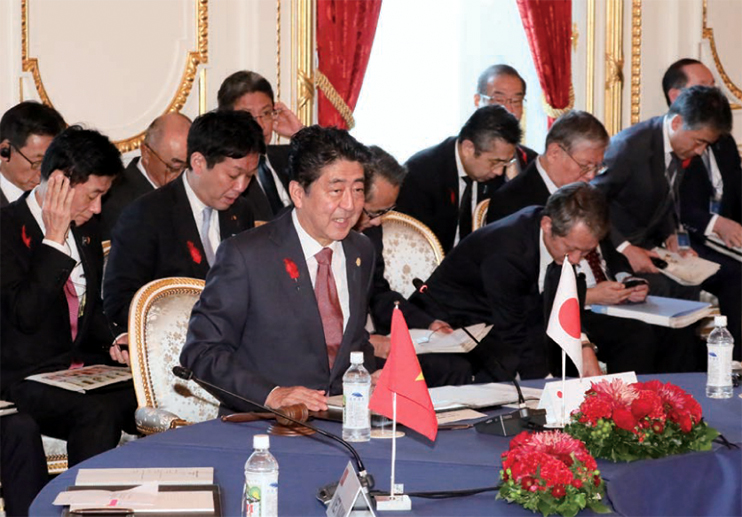
Prime Minister Shinzo Abe announcing the “Tokyo Strategy 2018 for Mekong-Japan Cooperation,” (details on here) which sets out the future direction of Japan-Mekong cooperation, at the 10th Japan-Mekong Summit Meeting held in Tokyo on October 9, 2018 (Photo: Cabinet Public Relations Office of the Government of Japan)

Prime Minister Shinzo Abe and Leaders of the Pacific island countries at the Eight Pacific Islands Leaders Meeting (Photo: Cabinet Public Relations Office of the Government of Japan)
In 2018, Japan made many efforts to realize a society in which “no one will be left behind,” the goal of the Sustainable Development Goals (SDGs), based on the concept of “human security,” which Japan has led in the international community over many years. Not only through providing conventional ODA to developing countries, but Japan has also carried out a number of initiatives on global issues, which need to be resolved urgently for both developed and developing countries, such as inequality and poverty, terrorism, refugees and displaced persons, environmental issues and climate change, and infectious diseases.
Examples of these initiatives include Japan’s proactive promotion of Universal Health Coverage (UHC), which seeks to provide all people, including those in developing countries, with affordable access to basic health services when needed. As part of this initiative, Japan has provided support to countries in Africa and across the world which have insufficient healthcare services and sanitation, and has strengthened its efforts to address infectious diseases, which can easily cross national borders and have grave effects on the entire international community as the world continues to globalize.
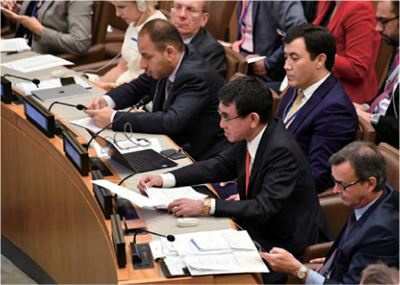
Foreign Minister Taro Kono announcing the provision of Japan’s grant aid totaling approximately $10 million, towards the Syrian citizens and refugees, as emergency and humanitarian aid through the WHO at the EU-hosted High Level Meeting on Syria in New York in September.

Foreign Minister Taro Kono giving a speech at the Tokyo International Conference on African Development (TICAD) Ministerial Meeting
Also, due to the recent conditions in Syria, Bangladesh and Myanmar, the number of refugees and displaced persons has grown to approximately 70 million in the world, which hits a record high since the end of World War II, and securing the lives, dignity and safety of these refugees and displaced persons is an issue of growing urgency. Japan is proactively providing humanitarian assistance to refugees and other people in vulnerable positions, such as women, disabled persons, and children in developing countries, as one of the priority issues, among others.
Furthermore, Japan has been strengthening its cooperation with a number of countries to realize the “Free and Open Indo-Pacific,” announced by Prime Minister Shinzo Abe in August 2016. Japan is carrying out an array of specific initiatives in fields such as freedom of navigation, the promotion and establishment of the rule of law, enhancing connectivity through quality infrastructure in accordance with international standards, and maritime security capacity building.
While prioritizing the aforementioned areas through development assistance, Japan continued its development cooperation across a wide range of projects in 2018. Based on the “Development Cooperation Charter,” Japan strives to tackle key issues, such as “Cooperation to achieve ‘Quality growth,’” which seeks to achieve economic growth that leads to self-reliant development in developing countries, “Sharing universal values and realizing a peaceful and secure society” to disseminate the shared values of freedom, democracy, basic human rights and the rule of law in developing countries, and thereby secure peace, stability and safety, and “efforts to address global challenges and the promotion of people-centered development.” Details on the achievements can be found in the subsequent section, Part II - Measures for Each Priority Issue.
In 2018, Japan hosted a number of international conferences related to development issues in developing countries, such as the “Eighth Pacific Islands Leaders Meeting” (PALM8) in May, the “Mekong-Japan Summit Meeting,” and the “Tokyo International Conference on African Development (TICAD) Ministerial Meeting” in October, and has advanced Japan’s development-related initiatives to address the challenges faced by each region. Japan’s initiatives in regions and countries throughout the world, including the aforementioned conferences, are introduced in Part III – Assistance for Each Region.
Until now, the Government of Japan and the Japan International Cooperation Agency (JICA) have served as the central drivers of ODA as part of Japan’s development cooperation, but in recent years there is an increasing need for a variety of actors (as implementing bodies), such as private corporations, NGOs, local governments and universities to each contribute their respective advantages in close cooperation. Japan is closely cooperating with a diverse range of domestic actors in efforts to address a number of development challenges. Recently, Japan has been cooperating with other donor countries to address key issues in development, as well as providing assistance through a wide range of international organizations.
Additionally, with the purpose of utilizing ODA even more efficiently and effectively, in 2018 Japan held a total of four meetings of the Advisory Board for ODA, which resulted in useful recommendations from experts on topics such as, “the division of roles in overall development cooperation, and consolidation of competition and cooperation.” Strengthening cooperation among diverse actors like this is becoming more essential day by day. The outcome of cooperation with a diverse range of actors in 2018, can be seen in Part IV, including columns on specific topics.
Furthermore, Japan is focusing on the development and strengthening of human resources who can succeed on the global stage in the field of development cooperation. Japan conducts the Junior Professional Officer (JPO) Programme, which dispatches young Japanese people to international organizations, who wish to become staff of international organizations, and allows them to accumulate experience, with the aim of attaining regular staff positions after their tenure. As such, Japan strives to nurture human resources that can be active in international organizations, including in the area of development cooperation.
• Japan’s Official Development Assistance in Terms of Disbursement
In 2017 (Note 1), Japan’s gross ODA disbursements amounted to approximately $18,461.20 million (¥2,071.0 billion). This represents an approximate 9.8% increase on a dollar basis (13.2% on a yen basis) compared to the previous year (2016). Japan’s net ODA disbursements, which are gross disbursements minus repayments of loan aid (Note 2), amounted to approximately $11,462.65 million (¥1,285.9 billion). This represents an approximate 10.0% increase on a dollar basis (13.5% on a yen basis) compared to the previous year. Japan ranked third, higher than the previous year, among the member countries of the Development Assistance Committee (DAC) of the Organisation for Economic Co-operation and Development (OECD), following the United States and Germany in terms of gross disbursements. In net disbursements, Japan ranked fourth (Note 3), the same as the previous year, following the United States, Germany, and the United Kingdom.
A breakdown of 2017 disbursements shows that in terms of gross disbursements, bilateral ODA accounted for approximately 81.7% of overall disbursements, while ODA towards international organizations accounted for approximately 18.3%, and in terms of net disbursements, bilateral ODA accounted for approximately 70.5% of overall disbursements, while ODA towards international organizations accounted for approximately 29.5%. Bilateral ODA is expected to contribute to the strengthening of Japan’s relations with recipient countries. Meanwhile, ODA towards international organizations enables Japan to support international organizations which have expertise and political neutrality and thereby, enables us to support countries and regions where direct assistance from the Government of Japan is difficult to reach. Japan is making flexible use of these types of assistance, as well as initiating coordination between them, while making every effort to ensure the “visibility of Japan” through properly providing aid.
When examined by aid scheme, the disbursements for bilateral ODA calculated as grant aid totaled approximately $2,616.53 million (¥293.5 billion), or approximately 14.2% of the total ODA gross disbursements. Among these grants, grant aid through international organizations accounted for approximately $1,344.94 million (¥150.9 billion), or approximately 7.3% of the total. Technical cooperation accounted for approximately $2,883.40 million (¥323.5 billion), or approximately 15.6% of the total. With regards to government loan, loan disbursements accounted for approximately $9,578.89 million (¥1,074.6 billion), or approximately 51.9% of the total gross disbursements of ODA. Net disbursements, which are loan disbursements from which repayment amounts are subtracted, accounted for approximately $2,580.35 million (¥289.5 billion).
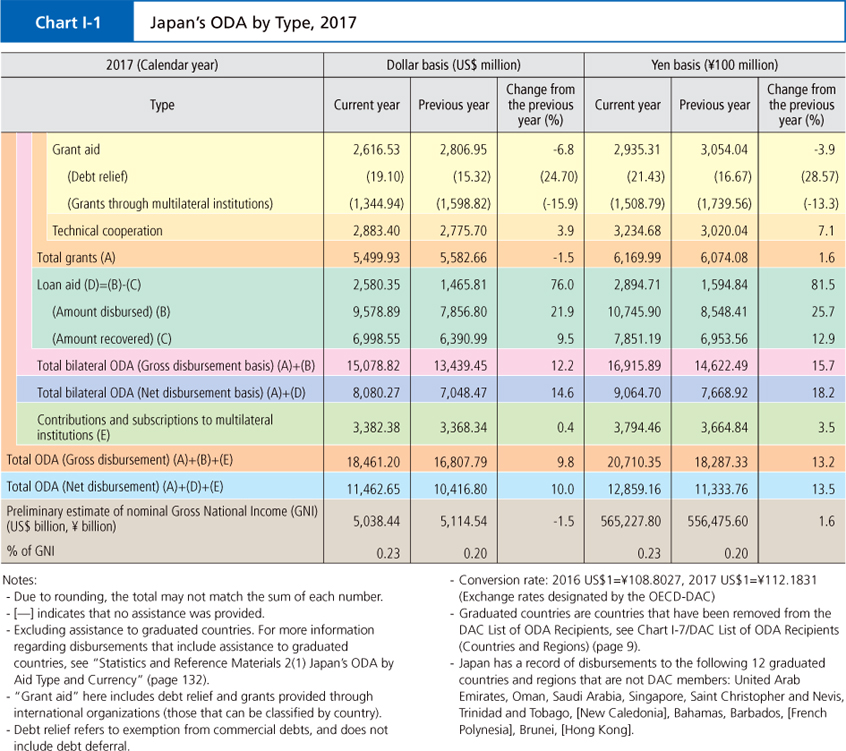
Japan’s bilateral ODA by region is as follows in the order of gross disbursement, net disbursements and percentage of total disbursements (The following disbursements include disbursements to graduated countries.)
♦ Asia: $9,009.43 million ($3,600.48 million) (59.7%)
♦ Middle East and North Africa: $1,735.16 million ($1,079.33 million) (11.5%)
♦ Africa: $1,7030.29 million ($1,594.70 million) (11.3%)
♦ Latin America and the Caribbean: $372.45 million ($343.91 million) (2.5%)
♦ Oceania: $321.74 million ($230.61 million) (2.1%)
♦ Europe: $192.75 million ($124.96 million) (0.6%)
♦ Assistance covering multiple regions: $1,849.94 million ($1,849.94 million) (12.3%)

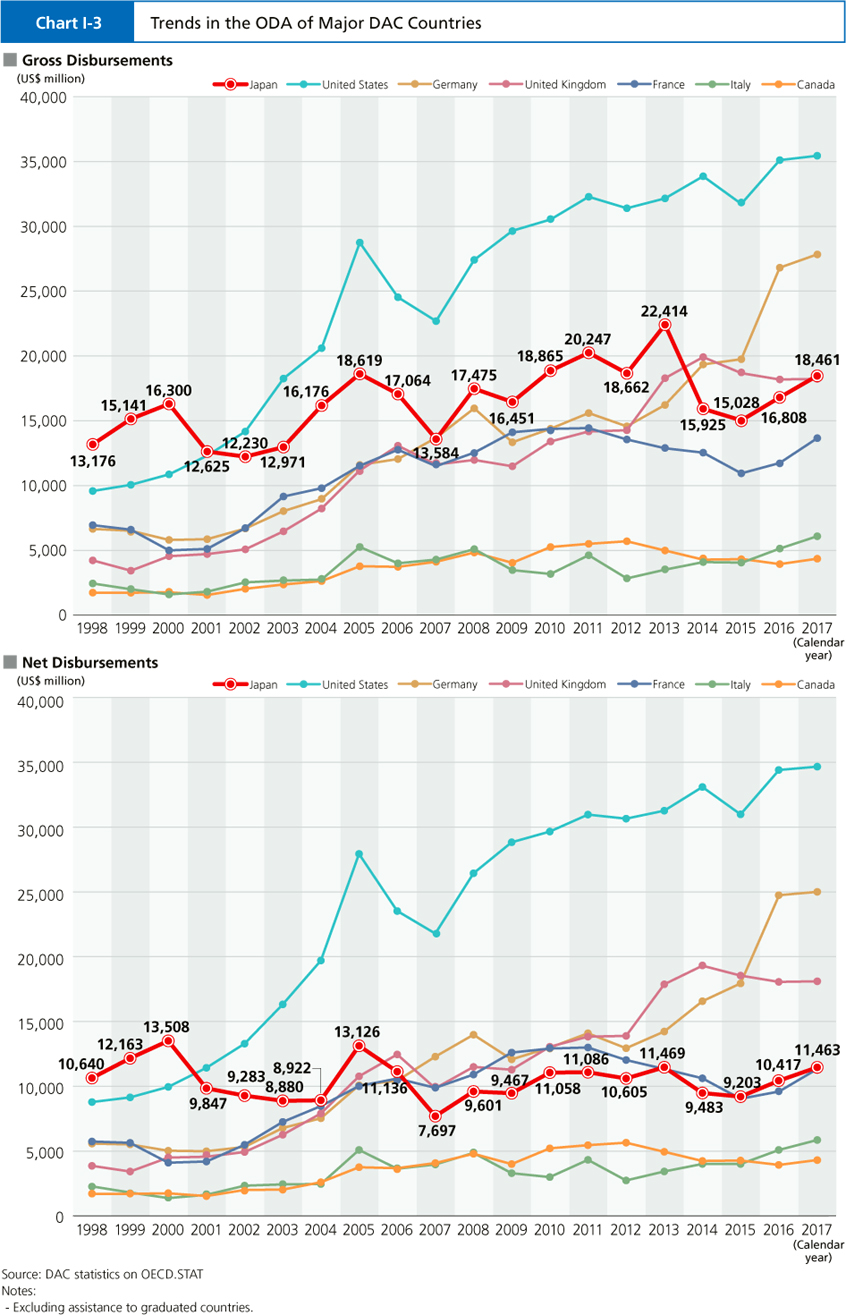
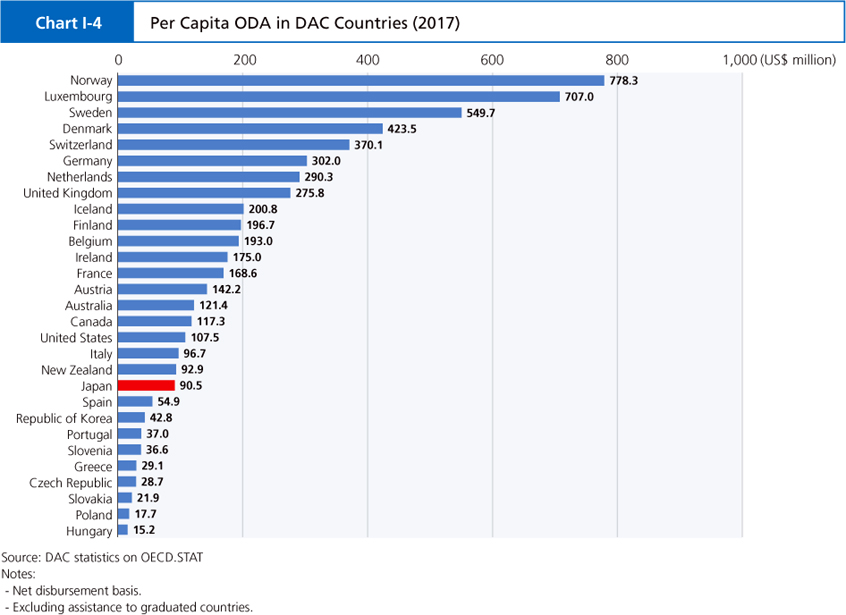


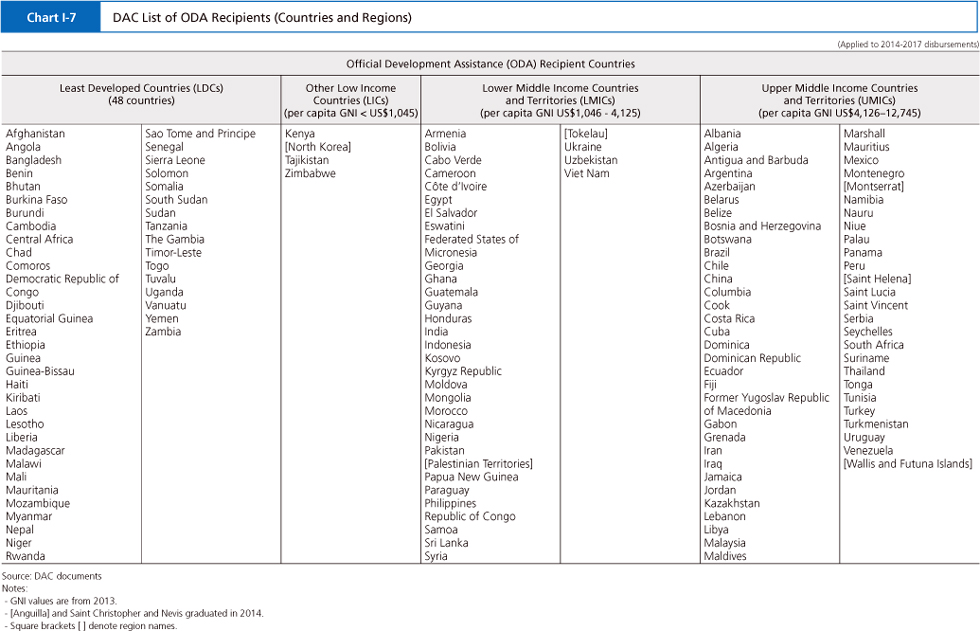
- Note 1: The amount of disbursements for 2018 is planned to be finalized at the end of 2019.
- Note 2: Gross and net disbursements are differentiated as follows:
Net disbursements = gross disbursements – amount recovered (repayment amounts of government loans from recipient countries to donor countries)
Net disbursements are usually used in international comparisons of aid disbursements. - Note 3: Excluding disbursements to graduated countries. For more information regarding disbursements that include graduated countries, refer to here.
